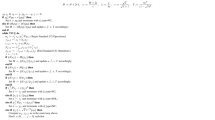Abstract
We derive a quadratically convergent algorithm for minimizing a nonlinear function subject to nonlinear equality constraints. We show, following Kaufman [4], how to compute efficiently the derivative of a basis of the subspace tangent to the feasible surface. The derivation minimizes the use of Lagrange multipliers, producing multiplier estimates as a by-product of other calculations. An extension of Kantorovich's theorem shows that the algorithm maintains quadratic convergence even if the basis of the tangent space changes abruptly from iteration to iteration. The algorithm and its quadratic convergence are known but the drivation is new, simple, and suggests several new modifications of the algorithm.
Similar content being viewed by others
References
J.E. Dennis and J.J. Moré, “Quasi-Newton methods, motivation and theory”,SIAM Review 19(1) (1977) 46–89.
P.E. Gill, W. Murray and M.H. Wright, Practical optimization (Academic Press, New York, 1981).
T. Kato,Perturbation theory for linear operators, 2nd edition, (Springer-Verlag, Berlin, 1980).
L. Kaufman, “A variable projection method for solving separable non-linear least squares problems”,BIT 15 (1975) 49–57.
J. Nocedal and M. Overton, “Projected Hessian updating algorithms for nonlinearly constrained optimization”, New York University Computer'Science Department, Report No. 95, 1983, submitted toSIAM Journal on Numerical Analysis.
A.M. Ostrowski,Solution of equations and systems of equations, 2nd edition, (Academic Press, New York, 1966).
S. Smale, “Convergent processes of price adjustment and global Newton Methods”,Journal of Mathematical Economics 3 (1976) 107–120.
M. Spivak,A Comprehensive Introduction to Differential Geometry (Publish or Perish Inc., Berkeley, CA, 1979).
R. Tapia, “Quasi-Newton method for equality constrained optimization: Equivalence of existing methods and a new implementation”, in: O. Mangasarian, R. Meyer and S. Robinson, eds.,Nonlinear Programming 3 (Academic Press, New York, 1978) pp. 125–164.
Author information
Authors and Affiliations
Rights and permissions
About this article
Cite this article
Goodman, J. Newton's method for constrained optimization. Mathematical Programming 33, 162–171 (1985). https://doi.org/10.1007/BF01582243
Received:
Revised:
Issue Date:
DOI: https://doi.org/10.1007/BF01582243



